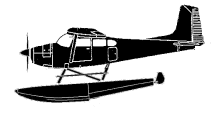
ASN Wikibase Occurrence # 199265
This information is added by users of ASN. Neither ASN nor the Flight Safety Foundation are responsible for the completeness or correctness of this information.
If you feel this information is incomplete or incorrect, you can submit corrected information.
| Date: | Monday 28 August 2017 |
| Time: | 13:12 |
| Type: |  Cessna 180J Skywagon |
| Owner/operator: | Private |
| Registration: | N180LP |
| MSN: | 18052344 |
| Year of manufacture: | 1973 |
| Engine model: | P. Ponk Aviation O-470-50 |
| Fatalities: | Fatalities: 0 / Occupants: 2 |
| Aircraft damage: | Substantial |
| Category: | Accident |
| Location: | near Gaylord, MI -
 United States of America United States of America
|
| Phase: | Landing |
| Nature: | Private |
| Departure airport: | Otsego Lake, MI |
| Otsego Lake, MI | |
| Investigating agency: | NTSB |
| Confidence Rating: |
The private pilot was flying the float-equipped Cessna 180J airplane at a low altitude when the engine lost total power. The pilot reported that the engine did not sputter, bang, or run roughly before the loss of engine power; however, several witnesses heard the airplane's engine running roughly immediately before the crash. One witness reported that the airplane's engine fluctuated between "sputtering" and "revving" before it lost total power. The airplane collided with trees and terrain during the subsequent forced landing and came to rest inverted.
Postaccident examination of the airplane and engine did not reveal any evidence of preimpact mechanical malfunctions or failures that would have precluded normal operation. Additionally, the airplane had ample fuel available that did not contain any water or debris. The engine also demonstrated the ability to produce rated horsepower during a postaccident operational test run. The carburetor heat control was in the "OFF" position.
The weather conditions at the time of the accident were conducive to moderate carburetor icing at cruise power and serious carburetor icing at descent power. The pilot reported that he did not use carburetor heat during the flight because he was operating the engine at a cruise power setting. The airplane flight manual states that carburetor heat should be used upon a loss of engine power or an unexplained decrease of manifold pressure, a roughly running engine, or before the throttle is moved to idle for landing. Additionally, the use of carburetor heat might be required to avoid carburetor ice accumulation during a descent at a reduced engine power setting. According to a Federal Aviation Administration Special Airworthiness Information Bulletin, pilots should use carburetor heat while in weather conditions where carburetor icing is probable. Based on the available information, the total loss of engine power was likely due to carburetor ice accumulation. Additionally, the low altitude at which the loss of engine power occurred precluded the pilot from reestablishing normal engine operation before the airplane descended into trees.
Probable Cause: The pilot's failure to use carburetor heat while operating in weather conditions that were conducive to carburetor ice formation, which resulted in a total loss of engine power due to carburetor ice accumulation.
Accident investigation:
 |
|
Sources:
NTSB
FAA register: http://registry.faa.gov/aircraftinquiry/NNum_Results.aspx?NNumbertxt=180LP
Location
Images:

Photo: NTSB
Revision history:
| Date/time | Contributor | Updates |
|---|---|---|
| 29-Aug-2017 07:50 | gerard57 | Added |
| 29-Aug-2017 12:47 | Aerossurance | Updated [Time, Location, Narrative] |
| 03-Sep-2017 01:24 | Geno | Updated [Aircraft type, Registration, Cn, Phase, Source, Narrative] |
| 06-Jul-2019 19:37 | ASN Update Bot | Updated [Time, Departure airport, Destination airport, Source, Damage, Narrative, Accident report, ] |
| 07-Jul-2019 09:49 | harro | Updated [Aircraft type, Source, Narrative, Photo] |
| 07-Jul-2019 09:57 | harro | Updated [Narrative] |
Corrections or additions? ... Edit this accident description
The Aviation Safety Network is an exclusive service provided by:


 ©2024 Flight Safety Foundation
©2024 Flight Safety Foundation